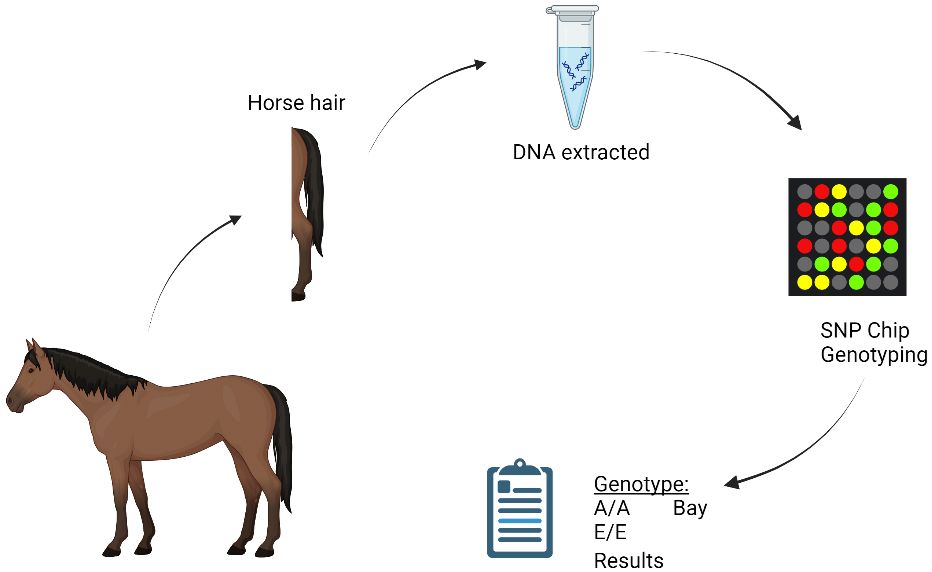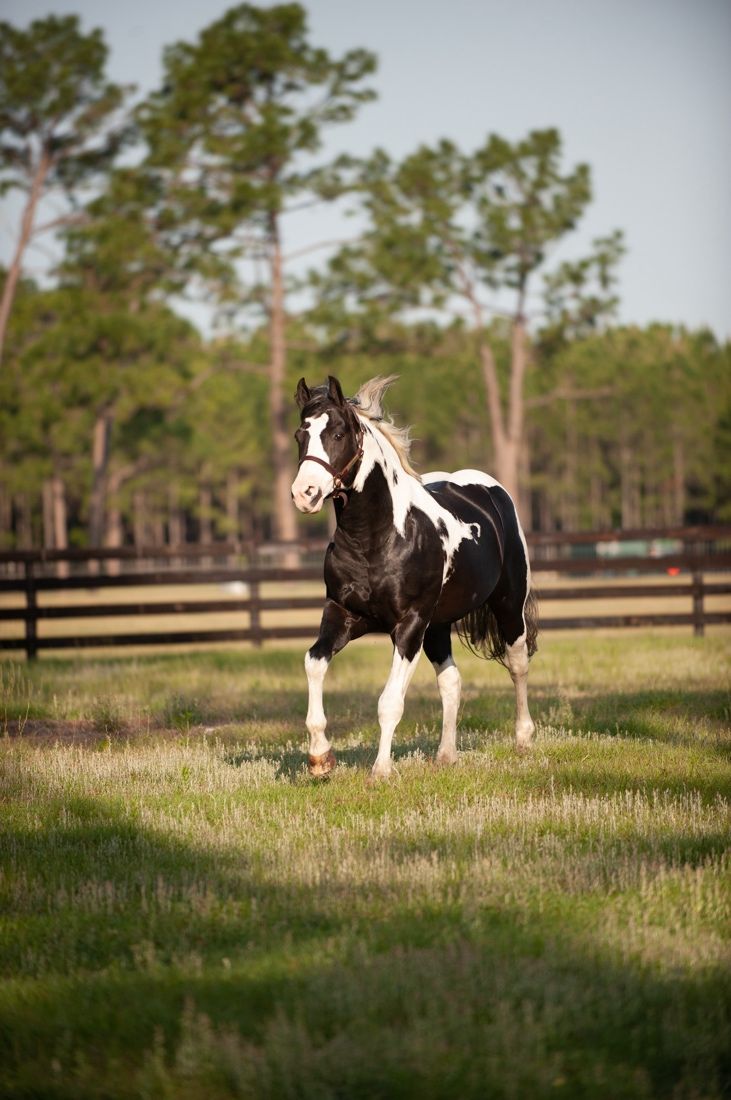Introduction
With the increasing development of genetic testing and advanced genomic technologies, horse owners and breeders have more opportunities than ever before to learn more about the genetic background of their horses. As more tests are developed, it is crucial for horse owners and breeders to understand what genetic testing services are, which genetic tests are available for their horses, and how to locate genetic testing services.
What is genetic testing?
Genetic testing is the process of analyzing a horse’s DNA for naturally occurring variations, some of which might be associated with individual traits. After a laboratory receives a customer’s sample from a horse, a laboratory protocol is used to extract the horse’s DNA and to separate the DNA from the blood or hair bulb. Hair is collected from a horse’s mane or tail and must contain the root or the bulb for DNA to be obtained. The extracted DNA is sequenced and genotyped using a single-nucleotide polymorphism (SNP) chip. The genotypes are then analyzed to determine the presence or absence of the mutation for a specific trait and are reported in the information sheet sent back to the customer. This process is outlined in Figure 1.

Credit: Julia L. Ciosek, created with Biorender.com
What genetic tests are available?
Genetic tests are widely available for a variety of traits. Since the early 1990s, the development of tests has continued to grow and expand as more discoveries are made. However, the most widely used genetic testing services for horses focus on offering tests for coat color and genetic diseases. For example, the horse in Figure 2 with tobiano patterning could be tested to determine the chances he will pass his patterning on to his offspring.

Credit: ©APHA/Paint Horse Journal (Used with permission)
An important collection of tests for genetic diseases is known by many horse owners as the “five-panel” test. The five-panel test is required by the American Quarter Horse Association (AQHA) and the American Paint Horse Association (APHA) for breeding stallions. The panel screens for the following common genetic diseases exhibited by Quarter Horse and Paint Horse populations:
- Glycogen-branching enzyme deficiency (GBED)
- Hereditary equine regional dermal asthenia (HERDA)
- Hyperkalemic periodic paralysis (HYPP)
- Malignant hyperthermia (MH)
- Polysaccharide storage myopathy Type 1 (PSSM1)
The results of this five-panel test are important to make informed breeding decisions for your horse aimed at limiting expression of genetic disease to the next generation, and making health management plans to limit the symptoms of genetic diseases so your horse can live a healthier and more productive life.
Parentage testing is another service provided by genetic testing companies and is very valuable information when registering horses in breed associations and creating pedigree records. Parentage testing relies on the concept of exclusion to detect genetic markers present in the offspring's genome that could not have come from the proposed sire or dam. If no exclusions are identified, then the parentage is accepted as likely correct.
The Basis of Genetic Testing
Diagnostic genetic testing does not determine if a horse is a certain breed. It looks for the presence or absence of a specific genetic marker. These genetic markers are often polymorphisms, the most utilized being single-nucleotide polymorphisms (SNPs). SNPs are abundant and involve one change in the nucleotide sequence in the DNA that may lead to a change in the expression of traits of interest.
Dominant and Recessive
Alleles or copies of a gene typically come in two different forms, dominant or recessive. “Dominant” and “recessive” are important concepts to know when predicting the inheritance of a trait. Each horse inherits one copy of each gene from their dam and one from the sire, and these two copies can be slightly different. A dominant allele will always mask the presence of a recessive allele, meaning your horse will always express the characteristics of a dominant trait when paired with a recessive allele because the recessive allele requires two copies to be expressed. The presence of a recessive allele can cause issues when a horse carrying the recessive allele for a debilitating condition is bred to another horse carrying the same recessive allele, because it provides the opportunity to produce a foal carrying two copies for that disease. An introduction and refresher to equine genetics can be found in Ask IFAS publication AN333, “Galloping into the Future: Genetic Tips and Tools for the Horse Owner.”
Which services offer genetic testing?
Several companies offer genetic testing for horses without the need for a prescription from a veterinarian. Commonly utilized services offering genetic testing are Animal Genetics, Inc., Etalon Diagnostics, and University of California, Davis Veterinary Genetics Laboratory. The costs for each test typically range from $20 to $50 per trait, and all the services listed above offer multi-panels for five or up to approximately 200 traits for about $100 to $200.
Animal Genetics, Inc. is based in Tallahassee, Florida, and offers a wide range of genetic tests for animal species, including horses. They offer testing for color, performance, genetic disorders, and parentage. Testing requires ordering a kit and sending samples of your horse’s hair.
Etalon Diagnostics is based in Menlo Park, California, and offers numerous tests to horse owners and breeders. Available tests include coat colors, abilities and performance, and genetic disorders. Parentage testing and ancestry analysis are also offered. Etalon Diagnostics is affiliated with the International Society for Animal Genetics and has licensed use of patented tests essential for veterinary interpretation and registration of horses. Forms can be downloaded online and sent in with your horse’s hair samples.
University of California, Davis Veterinary Genetics Laboratory (UCD-VGL) is based in Davis, California, and is affiliated with the University of California, Davis. Tests are available for coat color, abilities and performance, and genetic disorders. Parentage testing is also offered. UCD-VGL also has an affiliation with the International Society for Animal Genetics and has an accreditation from the ANAB ANSI National Accreditation Board.
How can I interpret my horse’s genetic testing results?
After receiving results, horse owners and breeders often receive an information sheet with their horse’s genotype information and carrier status. The sheet typically contains information about each test conducted, the trait tested for, and genotype. Figure 3 shows an example of an information sheet.

Credit: Julia L. Ciosek, UF/IFAS
Genotypes are typically presented by having two alleles reported for each trait. Below is an interpretation of the example from the testing report in Figure 3 for sample genotypes for HYPP, a dominant disorder, and chestnut, an autosomal recessive trait:
Albert E. Gator, a ranch horse from central Florida, tested positive for chestnut since he reports a genotype of e/e, meaning he carries the two recessive copies needed to exhibit a chestnut phenotype. A horse testing negative for chestnut might report a genotype of N/N if both parents did not have a chestnut allele, N meaning the absence of the copy of the gene for the condition. A horse testing negative for chestnut might also report a genotype of N/e, because chestnut requires two copies of the recessive allele.
Albert also tested positive for HYPP, since he reported a genotype of HYPP/N, meaning the horse carries one dominant copy for the condition and will have a 50% chance of passing on the dominant allele to his offspring and he may show signs of the disease. If he carried two copies of the gene, his genotype would be HYPP/HYPP, and his clinical signs of HYPP disease would be more severe. If Albert did not have HYPP, the report would indicate a genotype of N/N, N meaning the absence of the copy of the gene for the condition.
HYPP is a genetic disorder that is impacted by the diet. Therefore, it is important to take careful consideration of grain, supplements, and forage offered to Albert. Albert E. Gator needs to have a special diet low in potassium to ensure he does not show signs of HYPP disease. He should likely not be used as a breeding stallion.
What does genetic testing mean for the horse owner and breeder?
Genetic testing offers the horse owner and breeder a chance to make informed breeding decisions when pairing a mare and a stallion together. Additionally, genetic testing gives valuable information for individualized management and can be an important tool for making veterinary decisions. As costs continue to decrease and more genetic discoveries are made, horse owners and breeders can use any of the popular testing services to learn more about their horse’s genetic background and health.
Acknowledgment
Thank you to the APHA/Paint Horse Journal and Jessica Hein for the use of the image of the tobiano horse in this article.
References
Aleman, M., J. Riehl, B. M. Aldridge, R. A. Lecouteur, J. L. Stott, and I. N. Pessah. 2004. “Association of a Mutation in the Ryanodine Receptor 1 Gene with Equine Malignant Hyperthermia.” Muscle & Nerve 30 (3): 356–365. https://doi.org/10.1002/mus.20084
Animal Genetics, Inc. 2023. “Animal Genetics.” https://animalgenetics.us/
Etalon Diagnostics. 2023. “Etalon Horse DNA Testing Services.” https://www.etalondx.com/services
Finno, C. J., and D. L. Bannasch. 2014. “Applied Equine Genetics.” Equine Veterinary Journal 46 (5): 538–544. https://doi.org/10.1111/evj.12294
Hammons, V., S. A. Brooks, and C. Wickens. 2020. “Needs Assessment: What are the barriers to use of equine genetic testing?” Journal of Equine Veterinary Science 85:102876. https://doi.org/10.1016/j.jevs.2019.102876
Patterson Rosa, L., C. Wickens, and S. A. Brooks. 2017. “Galloping into the Future: Genetic Tips and Tools for the Horse Owner: AN333, 5/2017.” EDIS 2017 (3). https://doi.org/10.32473/edis-an333-2017
Rudolph, J. A., S. J. Spier, G. Byrns, C. V. Rojas, D. Bernoco, and E. P. Hoffman. 1992. “Periodic Paralysis in Quarter Horses: A Sodium Channel Mutation Disseminated by Selective Breeding.” Nature Genetics 2 (2): 144–147. https://doi.org/10.1038/ng1092-144
Tryon, R. C., S. D. White, and D. L. Bannasch. 2007. “Homozygosity mapping approach identifies a missense mutation in equine cyclophilin B (PPIB) associated with HERDA in the American Quarter Horse.” Genomics 90 (1): 93–102. https://doi.org/10.1016/j.ygeno.2007.03.009
UC Davis Veterinary Medicine. 2023. “Veterinary Genetics Laboratory.” https://vgl.ucdavis.edu/
Ward, T. L., S. J. Valberg, D. L. Adelson, C. A. Abbey, M. M. Binns, and J. R. Mickelson. 2004. “Glycogen Branching Enzyme (GBE1) Mutation Causing Equine Glycogen Storage Disease IV.” Mammalian Genome 15:570–577. https://doi.org/10.1007/s00335-004-2369-1